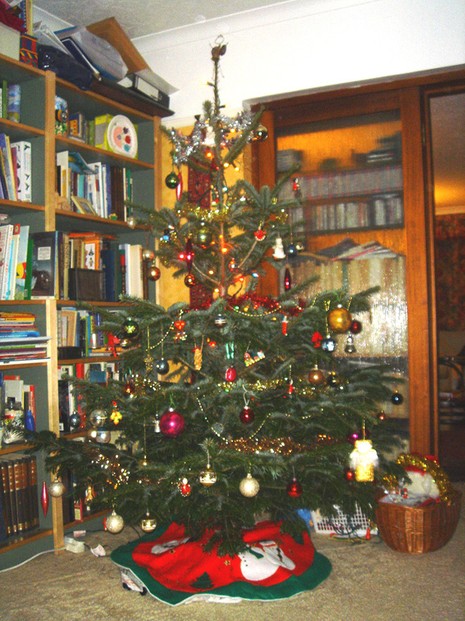The Christian festivals of Christmas, Easter and Thanksgiving have their origins in Pagan celebrations to mark the times around the solstices and equinoxes. Here, Steve Rogerson looks at some of the theories as to how these celebrations have evolved and at how the summer solstice remains a unique Pagan celebration.

Pagan Origins of Christian Festivals
A look at the origins of religious celebrations around the solstice and equinox
 The Christmas tree started as a fertility gift Photo by Steve Rogerson |
Christians around the world celebrate the festivals of Christmas and Easter and in North America they also celebrate Thanksgiving, but all three of these festivals have their origins in Pagan festivals celebrating the solstices and equinoxes. For the purposes of this article, the seasons are given as they fall in the Northern Hemisphere; in the Southern Hemisphere they are obviously reversed with winter and summer swapping over and autumn and spring likewise.
Easter – Spring Equinox
Even the word Easter has Pagan origins but whether it came from Eostre, the mother goddess of the Saxon people in northern Europe, or – more likely – the Teutonic dawn goddess of fertility Eostra is debateable, though probably both these goddesses had the same origin related to “eastre”, an ancient word for spring. There are other goddesses as well that appear to have similar origins such as Ostara, a Norse goddess of fertility, and Astarte from ancient Greece. The symbol of Ostara was the hare and could be the origin of the Easter bunny.
Christians also don’t have the monopoly on Easter marking a resurrection. Some 2000 years before the story of Jesus Christ the Babylonians celebrated the resurrection of their god Tammuz by his mother Ishtar (another possible origin of the word Easter). Part of this celebration involved painting eggs and hiding them for children to find. In fact the egg, as a symbol of fertility, can be found in many ancient cultures and religions in celebrations associated with spring.
Southern Europe also had an equinox celebration for Cybele, the Phrygian goddess of fertility whose consort Attis, believed to be born of a virgin, was said to have died and been resurrected three days later. Virgin births and resurrections are common themes in many early religions.
Thanksgiving – Autumn Equinox
Though some claim that the USA invented Thanksgiving, this is not the case and there are isolated thanksgiving festivals in Europe that date back well before the USA started its celebrations of this holiday.
What the USA did was move Thanksgiving to roughly two months after the equinox, but that should not disguise the fact that the equinox is its true origin. The USA used to celebrate thanksgiving on 3 October, or just over a week after the equinox but former US president Abraham Lincoln changed this in 1863 to late November.
Other names for the autumn equinox include Witch’s Thanksgiving and the Harvest Home and it was the celebration in which pagans gave thanks for the harvest, hence the modern name thanksgiving. The full moon nearest to the autumn equinox is called the harvest moon as it marked the deadline for farmers to harvest their crops. In mediaeval times, the Christian church tried to replace this celebration with one for the archangel Michael, hence Michaelmas.
The festival has also been known as Mabon after the Welsh god Mabon ap Modron.
Christmas – Winter Solstice
There have been over the years numerous celebrations around the winter solstice and aspects of many of them feature in the Christmas celebrations of today. One of the earliest references is the Babylonian feast of the Son of Isis, which involved eating, drinking and the giving of gifts. The word yule originates from northern European Pagan celebrations around the sun god Mithras. Yule literally means “wheel”, a Pagan symbol for the sun. The yule log was a large log brought indoors on the solstice and was meant to burn in the fireplace for twelve days, the origin of the twelve days of Christmas.
Kissing under the mistletoe was a Pagan fertility ritual and the red berries of holly were considered food of the gods.
The tradition of bringing an evergreen tree into the house was a mark of respect to the fertility gods so they would bring back plant growth in the spring. The Romans had a winter holiday honouring Saturn, the god of agriculture, the celebrations of which involved placing candles in live trees.
Summer Solstice
The summer solstice stands out as the one that has not been adopted by Christianity and is still celebrated as a Pagan festival in many parts of the world. Monuments such as Stonehenge in England attract followers every June to celebrate the solstice. In the USA, though, there are midsummer celebrations less than two weeks after the solstice on 4 July to mark Independence Day. And in France, Bastille Day is celebrated on 14 July.
You might also like
Kissing Under the MistletoeA look at the origins of the custom of kissing under the misteltoe
Pagan Fertility Rituals and RitesSome modern traditions have their origins in Pagan fertility rites






 KZine Issue 31: Review of October 2021 Issueon 11/07/2021
KZine Issue 31: Review of October 2021 Issueon 11/07/2021
 KZine Issue 30: Review of June 2021 Issueon 07/05/2021
KZine Issue 30: Review of June 2021 Issueon 07/05/2021
 KZine Issue 29: Review of February 2021 Issueon 02/23/2021
KZine Issue 29: Review of February 2021 Issueon 02/23/2021
 KZine Issue 28: Review of September 2020 Issueon 10/01/2020
KZine Issue 28: Review of September 2020 Issueon 10/01/2020



Comments
SteveRogerson, Thank you for product lines, pretty pictures and practical information.
In particular, I admire your photo of the Christmas tree. It's beautifully trimmed.
It's interesting about resurrected individuals in other cultures at other times. Wouldn't Isis reviving Osiris number among those antecedents?
In particular, I like the resulting imagery of Romans placing lighted candles in live trees. Would the candles have been placed within something or would they just have been used on very calm days?